And, mind you, for a driving geek like me, that's inspiring and motivating. In a market where all manufacturers seem extremely fearful of launching anything that might cause the slightest criticism or fear on the part of press and customers, Abarth has put two... pistons in it, to create a radical machine, so radical that it comes as close to a rally car as you'll ever find on the tracks. So radical that it's as close to a rally car as you'll ever find on the tracks, and I'm not talking about looks or equipment, I'm talking about what you feel when you get behind the wheel.
The Biposto is Abarth's return to its traditional path. Under the baton of Carlo Abarth, the firm always went to extremes of this kind. Uncompromising cars often nicknamed "monsters", which reached preparations that large series manufacturers did not dare to make. The house of the scorpion reborn this century had so far avoided going to these extremes. It had done so with limited editions with more name and aesthetics than substance. But that's over. The Biposto is a punch on the table. A "here I am". And yes, the result is as surprising as it is radical and exciting.
Whether it's a recommendable product is another matter to analyse. But to draw any conclusions you'll have to join me for the next few paragraphs, where I'll analyse the car in depth after spending a famous week alone with it. Are you in?
Design
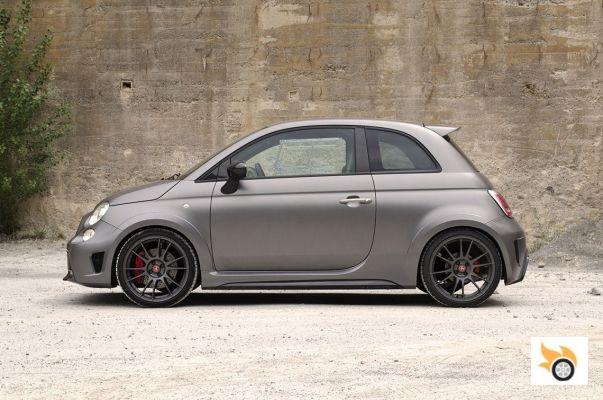
After eight years on the market, the 500's overall shape won't surprise you now. What does surprise you is that it's aged so well. So much so that one wonders if it's really worth even thinking about any updates beyond slapping on LED headlights and the odd minor detail tweak.
A year after arriving on the market, the 500 received its sporty treatment from Abarth, and since then, beyond chromatic and detail modifications, we haven't seen any major aesthetic developments either. Until the arrival of this Biposto.
The car is one of those typical cases in which it looks much (much) better live than in a photo. I told you about it last year when I had the chance to test it in Italy at Christmas. And the colour, a dark satin grey with peculiar touches and shines, convinces in your presence. The car, at medium distance, looks lower, wider, better planted on the road. And the wheels, which look comically large in the photo, are perfectly integrated into the design.
It does not change much aesthetically, but enough to look like a more macho car, better planted on the asphalt, which wins over the photos in person.
Going part by part, the front starts with a new, more prominent bumper. It has grown forward to accommodate a single large front intercooler (the normal 500 has two small ones, on the sides, in front of the wheels). The sides of the aforementioned bumper go down straighter, placing the car more on the road, while its central part, the air intake, is made of genuine carbon fibre, giving the car a mouth "with presence and prestige".
The headlights do without xenon, while the hood, optionally, can be like the one in the pictures, that is, aluminum and with two integrated humps. They try to successfully emulate those seen on the Fiat 124 Abarth Spider. In addition, the use of an aluminum hood is an instant weight saving that is noticeable as soon as you open the nose to see the guts it hides.
If we continue along the three-quarter front we find the wheels signed by OZ, Ultraleggera model, very open and large (18 inches, a record for a production Abarth 500), which promise to save kilos on the scale. They are shod for the occasion on GoodYear tyres with a 215 millimetre section and only 35% profile. Abarth dispenses with its declared technical partner, Michelin, for reasons of weight: it does not manufacture tires with the dimensions required by the car.
Behind the rims we find the Brembo brakes already seen on numerous occasions before. These are rigid four-piston calipers that bite into ventilated and drilled steel discs, as well as floating on aluminum alloy bells. The shape of the side air outlet that goes just in front of the wheel changes. It no longer serves to extract air from the intercooler.
On the wheels we find a very discreet, only 15 millimeters, which serve to cover the extra track width of the car. They are perfectly integrated into the shape of the car, and its curve follows the original of the fin, and integrates seamlessly into the front bumper.
The side skirts are completely new, fatter and with a carbon fiber piece that looks spectacular and at the same time, spectacularly exposed to scratches and deterioration. It emphasizes the new way in which the car "sticks" to the ground visually, and emphasizes the presence and masculinity of the footprint, without resorting to excesses.
There's no "695" side logo just behind the door, nor the typical Abarth badge (curious), but the door handle changes colour, to be offered in "titanium finish" (no, it's not titanium, it's just the colour of the plastic), accompanying the front moustache and the upper frame of the rear number plate.
The polycarbonate windows give a racing touch to the car (we'll talk later about what happens when you use them...), while the mirrors get real carbon fiber covers, but only in the "carbon finish" pack. They look good, yes.
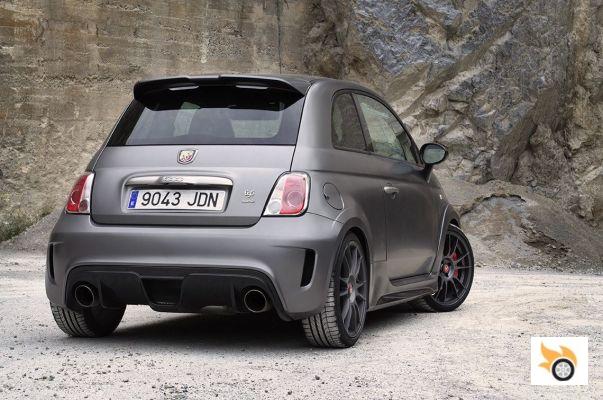
The change of view for the three-quarter rear reveals a revamped rear bumper, which embraces the extra wings, and which houses a carbon fibre diffuser that looks simply great. The Akrapovic exhaust tails are thick and fill the diffuser well, although they could stand out a hair more for my taste.
The rear hood dispenses "for weight reasons", they say, with the rear window wiper, while over it hangs a new spoiler with two air passages through it. Just in front, the radio antenna leaves its place to a design cap that reads "695 Biposto", and that serves to cover the hole in the stamped plate where the antenna goes in the standard models. Because no, this car doesn't have a radio.
However, the fins, the shape of the skirts, the size of the rims, the extra track width and the ground clearance combine to "plant" the Biposto on the road and make even those who don't know about cars get the impression that this 500 is "not normal", it has something "special".
Cabin
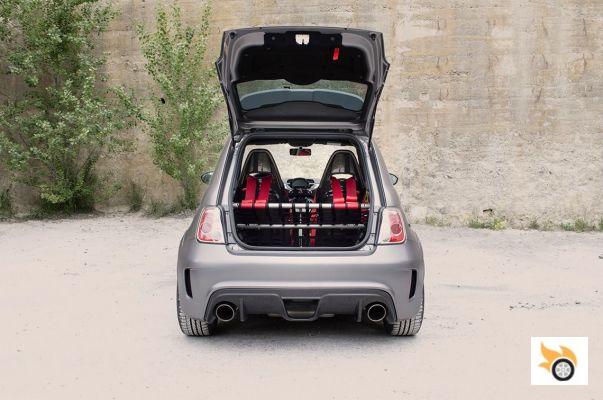
The most striking, obvious and important thing about the interior of the Abarth 695 Biposto is an absence: there are no rear seats. Their place is replaced by the presence of a series of chassis reinforcement bars made of titanium and bolted to the frame, so as to prevent the frame from flexing under the loads induced by cornering and bumps in the tyres.
No, it's not a "safety cage", nor is it a "roll bar". It's not the former, because it doesn't reach the roof and in case of a rollover, it won't protect us any more than the standard car. It's not an "anti-roll bar" either, because that's an anti-roll bar, and those who write press releases and technical specifications for cars still don't realize that they've been doing it wrong for years. Someday they'll learn, I say. It would be enough for them to read us sometime and understand that an anti-roll bar serves to "avoid rollover", and therefore, it has to be an anti-roll bar, which is the only mechanical element of a car destined to such a function.
The protagonists of the interior are the Bacci Romano gearbox, which looks like a work of art, and the absence of rear seats.
Pedantic phase overcome, I continue with what matters, which is the interior of the car. The set of titanium bars is covered with a black intertwined netting that looks very cute (they call it a helmet holder, although it's not really a helmet holder either) and serves to prevent whatever you load in the new and discovered huge trunk from coming against you while you use the car. It also serves as an anchor point for the optional harnesses of the "track kit" of the car, which are not homologated for use on the open road, and must be relegated to be used in track days if you don't want a fine.
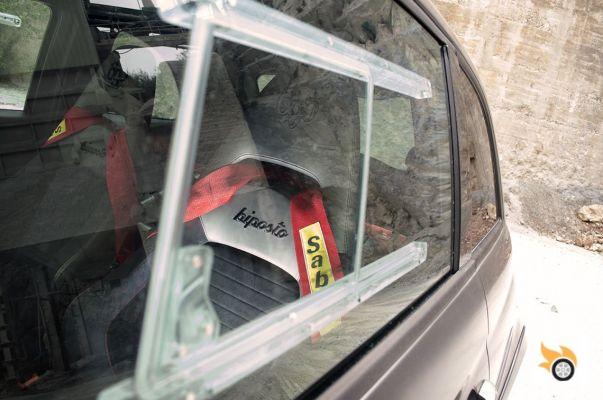
The front seats are the well-known Sabelt of the brand, with a carbon fiber structure seen for the occasion (like those of the Ferrari Tribute) and an upholstery also specific. They look great, but they are not identical in position and hardness to the rest of the Abarth range. They are a hair higher (I'm not sure why) and their upholstery is clearly harder. They are "more rally", and in fact, sitting down you feel as if you were at the controls of the 500 R3T.
This feeling is further reinforced when you glance at the centre console and appreciate the digital display of the AIM data acquisition system that, again as an option, is fitted to this unit. In front of you is the digital instrument panel, which is standard across the Abarth range, and which, in my opinion, is not as useful as the traditional analogue one. Why? Well, while on the regular 500 range it's better than the old one (thanks to the fact that it allows better handling of the infotainment system and shows the speed more clearly), on these Abarth relegates the lap counter to the far right, where it occupies a small and difficult to see place. What's worse, it's calibrated up to 8,000 rpm, when the engine doesn't go above 6,500, which means the bar only goes up to two thirds of its height. So, we complain about its small size, and they reduce its range of use even more.
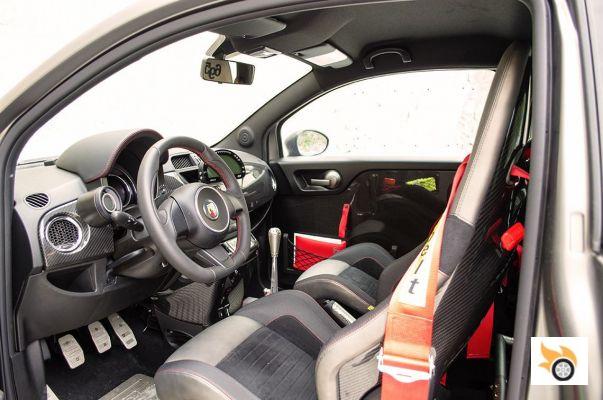
In addition to the absence of rear seats, the other main protagonist of the interior is none other than the Bacci Romano gearshift system. But beware, it is optional and not standard. It's a gearbox, whose mechanical operation we described some time ago (we'll talk more about it below). Aesthetically, the fact of having the selector exposed, without plastic covering it, creates a work of craftsmanship that makes the cabin a "very nice" place, really.
The carbon fibre, another option for the interior, does preside over everything you look at and touch. It is executed with great care, and in the door panels it is complemented with red strips to close the doors and "lighten the weight". The car couldn't be more racing, and when you're sitting inside, especially if you put on the harnesses, I can assure you that you have the feeling of being in front of a "purebred" rally machine.
Technique
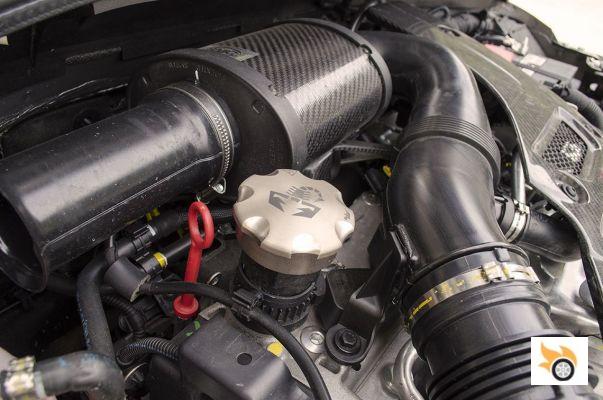
The heart of the Biposto is none other than Fiat's timeless TJet. The four-cylinder, itself derived from the even older FIRE engine (1986!) is the same as in the rest of the 500 range, and it's the same engine we love for its character and bravado. In fact, as we've said on more than one occasion, we're more motivated by this engine than the MultiAir born to take over from it, but which is flatter in its response, and although it's more powerful and efficient, in the end it doesn't have that "old school" sound and punch of the TJet.
On top of the familiar base engine, the Biposto adds a new intake system with a BMC conical filter (yes, identical to the one we used on the Abarth 500 we have on our long-term test), which is located across the rocker cover. The air sucked through the filter goes to a Garrett turbocharger (Honeywell, yes). This is the same turbo used in the Ferrari Tributo, with more displacement volume, capable of delivering more boost to the engine more consistently than the IHI turbo of the standard Abarth 500, even if it comes at the cost of a hair more lag.
Once the intake air is compressed, it passes through a front intercooler which, as mentioned before, cancels out the two side intercoolers fitted to the standard car, with the new one being more efficient at cooling the intake air, allowing you to get more out of it.
Due to the new position of the intercooler and its dimensions, the standard air conditioning condenser cannot be placed in front of the engine radiator, which means that neither air conditioning nor climate control can be fitted to the Biposto. And this, in 2015, can be a problem.
At less than a tonne for 190 horsepower, the 695 Biposto promises to do the 60 in under six seconds, a record in its category.
Returning to the engine, and after passing intake and supercharging, the mixture reaches the interior of the engine which is otherwise more or less stock, before going to the exhaust manifold. The exhaust line is the one signed by Akrapovic, and that was an optional until now. It has an active lever that can leave the exhaust "in free mode", or it can silence the engine a bit more. Here's a trick in that regard.
When you buy the Akrapovic exhaust system from an authorized dealer of the scorpion brand (coincidence of life, or maybe not, that the Abarth logo and the Akrapovic logo are the same), they offer you to mount a separate button to activate this toggle. When you activate it you go to free exhaust, and therefore it can only be used in circuit or closed section, as it is de facto illegal to circulate on open road.
Abarth has condensed the activation of this toggle to the "Sport" button. You know that the "Sport" button activates the car's sport mode on many fronts: It stiffens steering assistance, brutalizes throttle pedal response, increases turbocharger pressure and... and now activates the exhaust toggle. As far as we can tell, this makes the car, with the "Sport" mode activated, "too loud" to drive legally on European roads. How to get rid of this? Simple: Sport mode is deactivated by default. Every time you start the car you have to press the button, whereas on normal Abarth cars it stays on if you leave it on the day before. Italian tricks, gentlemen.
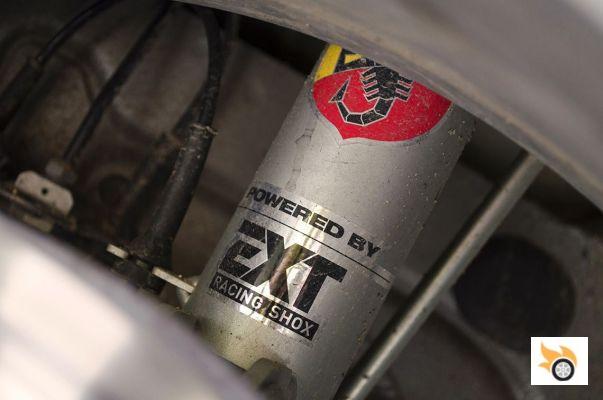
The engine puts out 190 hp at 5750 rpm, while the maximum torque is 250 Nm at 3000 rpm. Thanks to these figures, the car is capable of launching from a standstill to 100 km/h in 5.9 seconds (depending on the chosen trim level), on its way to a top speed of 230 per hour. 80-120? We timed it in third gear in just four seconds. Let's put it in perspective: Our prepped Abarth 500 does it in 4.5 seconds now that it has 180 horsepower, while a MINI JCW GP (the second-generation two-seater) clocked it in 3.6 seconds. Not bad, right?
Beyond the engine, it's the Bacci Romano gearbox that adds a new dimension to the car. It's not standard, but it's the Biposto's "star" option. It has the same five ratios as the normal Abarth 500, but does away with the shift synchromesh in favour of "dog-faced" selectors, which allow you to change gear more quickly when you're in gear (when you're not, that's another matter, as we'll tell you below). It also has a self-locking disc differential in its casing, which is the key to beating the six-second mark in acceleration to 100 mph, as it is capable of finding more traction where the other Abarths make the front wheels slip, despite the TTC.
The Extreme Racing Shox suspension is fully adjustable in height as well as in its compression and rebound valves.
Ground contact, as we've already told you, is provided by 215/35 tyres. They sit on 18-inch rims, which in turn rest on a set of hubs that offer an extra nine millimetres of track width on both axles. The tires are bolted to the hubs with studs and nuts instead of bolts.
The tubes rest on suspensions signed by Racing Shox, of the Extreme Shox brand, which in addition to offering a weight of unsprung mass much lower than the standard suspensions (35% less than the Koni FSD), have a firmer setting and an adjustable damping system, both in compression and rebound and rebound.
The main spring, adjustable in preload by means of the threaded body of the damping, has a small secondary spring that works as an "elastic stop" of the travel and also cures some kind of oscillations in case of small bumps. All in all, the aim is to keep the tyre as close to the road as possible for as long as possible.
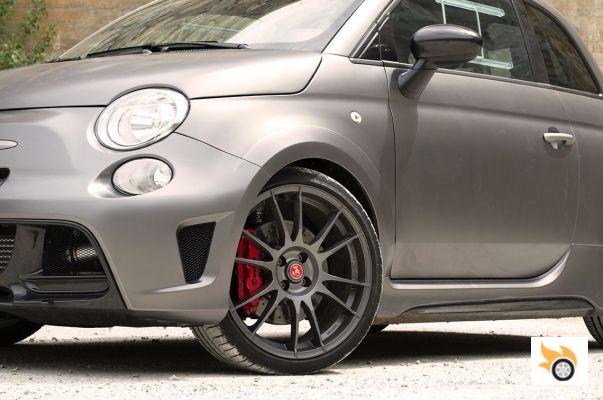
The braking is provided, as we said above, by Brembo. For the rest, the rest of the car is "pretty standard", although thanks to the measures and components used, its weight on the scales, with all the optional extras included (polycarbonate windows too), is 997 kilos (power to weight ratio of 5.24 kilos per horsepower).
Consumption? do you really want this data in this car? Well, it's even good: 6.2 litres on average in a mixed European driving cycle. But after the technical, aesthetic and habitability explanations, it's time to drive.
Driving
The initial plan with the Biposto was a genuine thrashing: A Logroño-Jerez to go to the MotoGP Grand Prix, and back, all in two days. Almost four thousand kilometres. I got on the Biposto and I was glad to have cancelled that adventure. It had been quite a few years since I had ridden in a car with polycarbonate windows and no air conditioning on conventional roads (since my rallying days). As soon as I did it, I travelled back in time to remember what it was like to "feel the heat". Just thinking about having to drive for hours with that oven and with the windows that hardly open at all and don't ventilate the cabin, I felt a shiver down my back. Since I became a father, I'm not in the mood for this kind of thing...
Well, to the heart of the situation. Key in the ignition, and the car starts up and comes to life like any other Abarth. The exhaust is not particularly present or annoying. It sounds Abarth, it sounds good, but it's manageable, not annoying. Finger on the Sport button and it gains a little more tone.
I engage the clutch and try to put it in first gear. It doesn't go in. I release the clutch, go back to first gear, now it does. Shifting without synchromesh has these things... The left pedal is much harder than the one in a standard Abarth, and the first few meters are accompanied by a dry tug when you engage the engine and front wheels.
It's not a good car to spend long afternoons driving around Madrid when it's 24 degrees. I don't want to think what it would be like to use it in Seville in August...
It doesn't matter how many times you practice, you'll still get the pull due to the design of the clutch and the gearbox. Well, what about the gearbox... Honestly, I've used these gearboxes before in races, but it's not until you get into the traffic of Madrid that you really notice the problems they cause. Especially if you get stuck in the start-stop of the city centre. Slowly downshifting from third to second is scraping through the gears as if you don't know how to drive. Double-clutching plus heel-toe is mandatory to get the speed up properly.
At a traffic light the guy next to you urges you to make "a fun outing". Don't worry, even if the car is able to do 0 to 100 in less than six seconds and thus beat many other specimens of the urban jungle, you will not get out in first gear, while you try to engage first gear after having been in neutral, the rest of the traffic will have moved, and if you hurry, they will even be using the horn.
I arrive to a car park, to park the car, and the window "ready to stamp the rally road book", is clearly an inconvenience to collect tickets. It doesn't cool the passenger compartment and you can't get your arm out of it either...
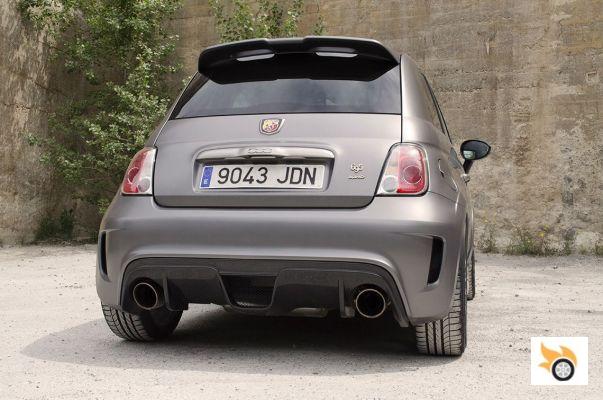
Potholes and speed bumps from "the lady mayoress" will only serve to confirm in less than an hour of urban driving that this car was not born, with these options fitted, to move around in an urban environment. And if you go out on the open road?
In that case, with 700 kilometers of highway that we put between chest and back it is not that we find a situation disproportionately better. As soon as you go over 90 mph, the polycarbonate windows become a tremendous aerodynamic nuisance, with a whistling noise that will try to deafen you. As there's no radio to cover the turbulence, the buzzing will give you a headache sooner rather than later.
The air-conditioning system without air-conditioning and these windows combine to slowly cook you up as I can only remember doing in an R5 GT Turbo on a rally in the middle of August. The gearbox is not so much of a problem here, once you play with the high gears, which are more docile to engage. The suspension, while stiff, is predictable, and the car sticks to the tarmac, even if you occasionally bounce a bit on the Sabelt seat, which due to its softness won't treat you too kindly either.
The Akrapovic exhaust is no problem here. With the wind whistling you can hardly hear it, all things considered. So yes, after I-don't-know-how-many-kilometres you're a wreck. Clearly this isn't the ideal environment for the Biposto, and any cheaper Abarth 500 (or the same Biposto with other options) will treat you better for commuting or around town.
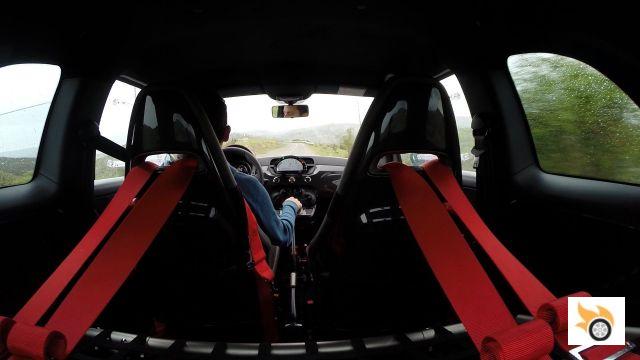
But this is like taking a footballer to the hospital and expecting him to be a brain surgeon, and then complaining about the results... The Biposto is not designed for this. And it's logical. For years you've read me complaining bitterly about how the overzealousness of manufacturers to create cars that were compensated, "good at everything, special at nothing", was destroying the dynamic essence of many of these cars.
The Biposto's natural domain has to be on twisty sections, or twisty circuits.
So after the sidereal beating, the alarm clock goes off at six in the morning and it's time to put on the Alpinestars and head for our favourite triple stretch of curves, with more than 120 kilometres to discover the hidden personality of the Biposto.
The first part of the track we tackle is a section of repetitive, very long second gear round corners, linked with fast third gear sections. We arrive to it with the car warm and with everything ready to take out doubts. The engine accelerates vigorously, while a curl of the asphalt that we know well in a false straight right makes us jump in the seat while the wheels are glued to the asphalt with a quick vertical movement. The trajectory doesn't break down.
When you take it out to have fun with it, it has no rival: It's like a rally car of the R3T category, with a nose that is inscribed millimetrically in the curves and a self-locking that gives a new dimension in driving sensations.
We approach the first curve. I put my right foot on the central pedal to take speed out of the equation. The first part of the brake pedal is null. I find this strange, because having tested other Abarth with this same brake system, they had a much more consistent brake pedal from the first touch, but something has to do that this unit has been riding in the hands of Marcos Martinez and Marc Gené days ago in Montmeló...
Once you get past that couple of millimetres of lack of action, the brakes bite hard and take away speed. I slow down. Fourth third without problems. Third second with decision and the Bacci Romano accepts my order at first. I concentrate on the steering wheel now. I take it out of its central position to apply a turn. The "rubbery" feel when separating from the central dead centre is still there, as in all 500s since eight years ago. Things of the electric assistance, I guess?
The car still doesn't pitch at all on the brakes, and putting the steering wheel in doesn't make it sway. It turns flat and pulls decisively to the apex. No other Abarth 500 I've tested has ever done it with such precision and desire, and without the rear end feeling as loose as on other occasions.
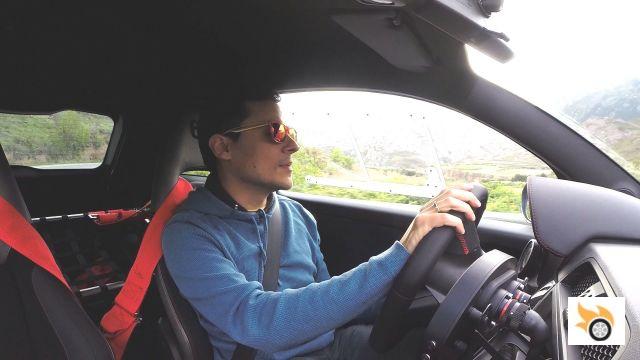
Such is the grip of the front end that there is no need to correct the line at all. As soon as I reach the apex, I press the gas pedal hard while taking the steering wheel off. The self-locking, even without having started to notice any hint of grip limit in the tyres, makes the car stick to the inside of the corner as soon as you put torque with the right foot. You have to hold it with desire and play with it. The car "talks to you" at that moment, it comes to life, something that through the steering wheel rim we had never seen before in a 500.
We exhaled out of the corner, launched into the next mini-straightaway with the feeling that we could have taken things much further. In the next collection of round corners I play more and more to tickle the car, always keeping the safety margins of open road, of course.
The nose always holds your bet and responds without dragging. The lock-up is noticeable not only in acceleration, but also in retention, helping the car to enter the corner with gusto. If you decide to get on the brakes and swing the car into the corner with a violent steering wheel, it also holds its own, the Biposto being less sensitive to the other Abarth's in this respect, and easier to demand, even if it is somewhat counter-intuitive, given its much greater grip margin.
It doesn't pitch, it doesn't sway, and it's not unstable even in the quickest of turns. It's a real dynamic poetry in chained curves and it makes you smile, although it crushes your body just as much as it thrills it.
The supports come almost immediately. You have to be used to driving "up there", as in all 500s, and erase that idea of "we're going to tip over". But once your brain is calibrated for it, you discover a car with a surreal cornering, which changes support without flinching in tenths of a second.
If you're going hard and in the middle of the turn, the rear end will be out of place, and it will do so by quite a few degrees if you've been looking for it "hard". The ESP is there, but it lets you try to catch the turn by hand. If you've failed when you've already had to put in a quarter of a counter-steer, the ESP will try to come to your rescue. It's not intrusive at all and lets you have fun much sooner.
It's clear that, as the damping is adjustable and fully configurable, the setting you use has a big influence here. The harder you set the rear shocks, the more playful you'll make the rear, so the Biposto plays with that variable personality window to suit whether you're more into "line-pulling" or Chris Harris-style drifting.
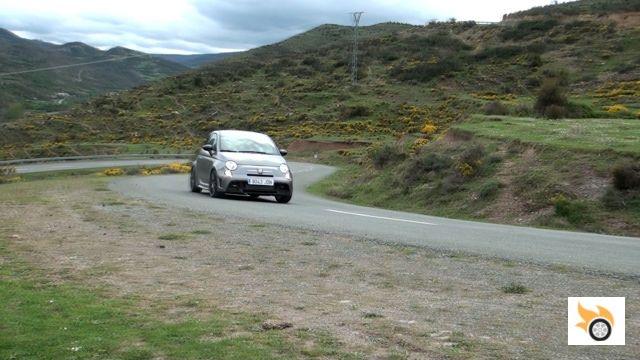
Engine response is quite brute. The turbocharger, capable of putting two bars of absolute pressure to the engine, is noticeable, and has its "good zone", which is always reachable thanks to the scaling of the gearbox, but as I say, it is not a "sweet" engine with a flat delivery, but has a concentrated kick, and that adds to the sensations, although it is not as modulable as a more progressive engine.
Giving gas and tightening the trajectory makes finding the limit of grip of the Goodyear on dry asphalt and open road, by pure torque at the exit of the curves, a complicated task. Such is the traction capacity and such is the ability to get the nose into the corners that you are positively amazed.
So I move on to the second section of road, this one much more broken and bumpy but not so round or tight curves. Here the damping surprises again. The car is able to keep the wheels very well glued to the asphalt, without bouncing and spitting you out of the curves. What the car doesn't "swallow", which at all costs is sticking the Goodyear to the asphalt, is swallowed by your kidneys and neck. It's a car that tires, like a rally car.
Only Abarth could be so crazy as to bring such a car to the market.
In this kind of sections, the play of bumps and self-locking makes the steering wheel have parasitic reactions. The Biposto then becomes one of those cars that you have to drive. It's not enough to aim, you have to correct and hold the steering wheel rim tightly to avoid losing the line. The self-locking makes that in full acceleration on bad asphalt, dirty with cow dung and broken by frost, the car pulls towards the wheel that has more grip and does not go completely straight. It reminds me here of the longed Focus RS of the first generation.
The gearbox is lightning fast when it comes to upshifting. A precise flick of the wrist and a quick stomp of the left foot is enough to get into the next gear. If you're lively and high in the air, you can shift up without pressing the clutch and the gearbox not only supports it, but I'd say it goes even better, like in my best rallies... Yes, sir.
The downside is the downshifts. Either you go "on fire" with them, and play wisely with the gas strokes, or if you want to sweeten and mark things a little more than usual, the turns will fall and the transition from third to second will become something scratchy and unpleasant, to the point of being able to run out of gear in the mouth of the curve ... something not recommended, similar to a coitus interruptus.
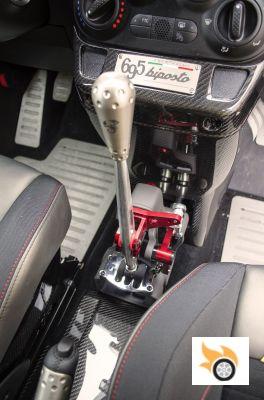
The last stretch of curves arrives, and I'm a happy man, smiling, but at the same time, tremendously tired. This piece of road is like a Nürburgring open to traffic in both directions. It's a very fast cornering, with first class asphalt. Here the Biposto, instead of being a critical car because of its short wheelbase, or unstable, proves to be even more comfortable than before, working with its suspension as it hadn't been able to do in the other road sections.
I would like to test it on the Nordschleife at the Nürburgring. Originally I was afraid of it, but after testing it on my roads, I think it will be a perfect tool for it.
It's devilishly quick, sticks to corners without roll, is immediate and works in tune with your mind, almost telepathically, even if the steering feel remains unconvincing at times. But there's feedback, and there's feel.
There's a unique area on this stretch of road. You're coming down into a fast left-hand corner going downhill, and you've got a climb, a "squeeze", with a short right-hand corner that turns into a fairly open left-hand support corner. You get into fourth gear very fast and you have to brake downhill, the car has to be able to go downhill and brake with the suspension well compressed up front as you change direction. And all by downshifting to third before you get to braking on full braking. It all happens very quickly and it's a challenge to the cars balance.
The Biposto, where I thought it was going to "dance in my hands", surprises and leaves me speechless: it brakes without pitching, downshifts smoothly with full throttle at full speed, and allows me to trace with millimetric precision. Foot on the brake in support and the rear does not scare me, the change of support is instantaneous again, and allows me to go for the throttle almost immediately. As the exit curve is fast, you give gas and the self-locking is not even noticed. You're flying low again.
It's great.
Such is the mastery demonstrated that I feel like trying this car at the Nürburgring, where not long ago I thought it would be a real madness because of its lack of length in relation to its setting and performance.
Conclusions
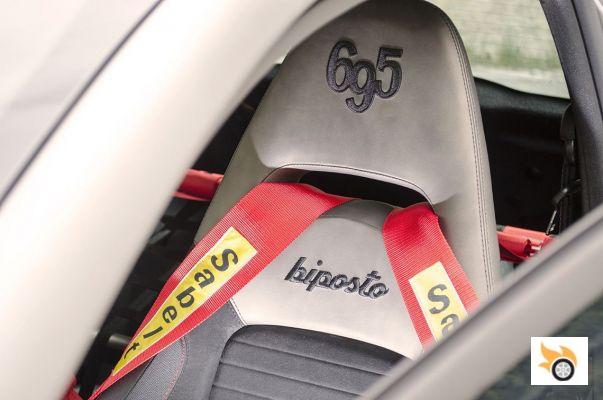
The good and the bad of the Biposto is in its uncompromising character. The good thing is that, thanks to not having to comply with everyone, it is capable of being the most effective 500 ever made. It has taken to extremes the base capability pioneered by the Fiat Panda, and has done so with a car that is as fun as it is effective.
The downside is that this road to dynamic excellence and fun has come at a cost that, for most customers, will be very hard to bear. And then there's the matter of options and price.
The suspension has an adjustment window that makes this Biposto also a car with multiple personalities, able to adapt to the optimal routes that each customer has as "fun zone". It is very 911 GT3 RS in that sense. The engine is powerful, the aesthetics, unique, and the touch of sensations as a whole is such that make you feel good for the mere fact of driving it.
But it's a car that tires, that tires a lot. Especially if you are going to use it as a "normal" car. The two days of filming the video of the car (which you will be able to see tomorrow), left me shattered. I was transported back to the days of rally racing and baking in the cockpit... Is this a downside or a compliment? It's clear that if you want a rally car for the street, for everyday use, there's nothing on the market that comes closer to the concept than the Biposto.
As I said before, the optional extras are a bit of a separate issue. Stripped out, the car is no more expensive than a MINI JCW GP, although stripped out it's not as fun or effective. Not being able to have air conditioning or radio seems very "cool" conceptually, very 911 GT3 RS, but the reality is that for anyone who is going to use the car "to go to work or to get bread" is going to be a liability, especially on summer days.
It's an extremely radical car, perfect for those who only want to use it for fun. For more intensive use, buy a 595 Competizione.
The polycarbonate windows (£3,000) take the weight out of the car, but they're a bad idea: they'll deafen you at 90+ mph (you'll need to wear tampons and/or a helmet), and they leak when you wash the car or when it's raining heavily.
The Bacci Romano gearbox is "a must" if you're going to buy the Biposto, in my opinion, as it's the element that gives the car the most character, but at the same time it's the element that conditions it the most. It costs 10.500€ (nothing less!), but it offers you a "racing" gearbox feel and above all, it has the self-locking differential, a fundamental part of the car's character. The downside? It's totally unusable for everyday use, especially in city driving, where it's a bit of a drag. You can find yourself trying to engage reverse six times before you get it to engage, or scraping into second while every pedestrian within two blocks looks at you thinking you don't know how to drive, at which point you get a "was that me?" look on your face.
The carbon fibre finish is a personal thing (£5,500), as is fitting the aluminium bonnet (£5,500 and if you look at the pictures it fits wrong!). The "track" kit of harnesses and AIM data acquisition system "gives the edge" and will be fine on the track if you do track day rides, but for daily use, in fact, I think it won't even pass the MOT (there is a suspicious asterisk, which I think invites you to remove the AIM system the day of the check), while the harnesses, as I said above, can't be used on the open road in a legal way.
Competition for the Biposto doesn't exist. Only the MINI JCW GP is an equivalent car, and it comes and goes like Guadiana. With it out of the market, there is no rival. If we factor in the MINI, I'll tell you that it was a much more usable everyday car, faster (slightly) and with more cornering. The Abarth has more character, yes, it feels better, but it'll wreck your body more in the process.
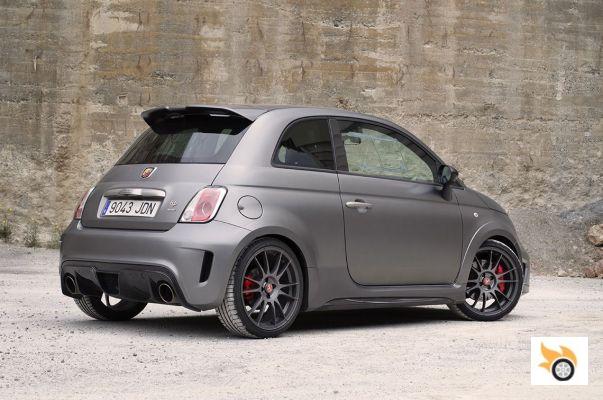
The Biposto is the result of a night of Abarth madness. An unjustifiable car in many ways, but with so much character and passion embedded in it that it's hard not to want one. But my advice is clear: buy it with the Bacci Romano gearbox and reduce its use to fun on curvy roads and track days. For a "total" use Abarth, it's more profitable a 595 Competizione and a few euros in preparation material. You'll have air conditioning, radio, two seats in the back, and you won't give up practically anything.
Only those who can afford to have a toy exclusively dedicated to enjoyment should think about the Biposto as a first choice. But I'm telling you this from reason. In the end the heart...
I leave you with the video. Don't miss it.
Test developed by Guille for The Scorpion Sting
























